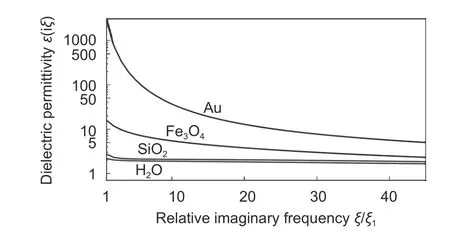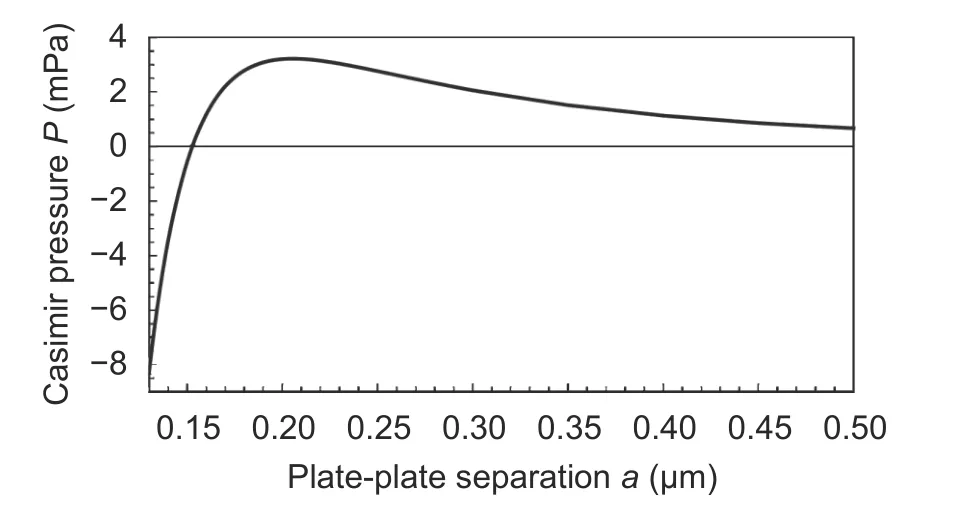Casimir Effect in Optoelectronic Devices Using Ferrofluids
Elena N.Velichko|Galina L.Klimchitskaya|Elina N.Nepomnyashchaya
Abstract—Some of the modern electronic and optoelectronic devices exploit ferrofluids contained in narrow gaps between two material plates.When the width of the gap becomes below a micrometer,the boundary plates are subjected to the Casimir force arising from the zero-point and thermal fluctuations of the electromagnetic field.These forces should be taken into account in microdevices with the dimensions decreased to below a micrometer.In this paper,we review recently performed calculations of the attractive Casimir pressure in three-layer systems containing a ferrofluid.We also find the ferrofluidic system where the Casimir pressure is repulsive.This result is obtained in the framework of the fundamental Lifshitz theory of van der Waals and Casimir forces.The conclusion is made that enhanced repulsion due to the presence of a ferrofluid may prevent from sticking of closely spaced elements of a microdevice.
1.Introduction
Considerable recent attention has been paid to the electronic and optoelectronic devices,such as switches,optical modulators,and biosensors,which exploit ferrofluids for their functionality[1]-[7].Ferrofluids are colloidal liquids which consist of nonmagnetic carrier liquids(for example kerosene or water)and magnetic nanoparticles(made,for example,of magnetite)suspended in it[8].To prevent their agglomerations,magnetic nanoparticles are usually coated with a surfactant which decreases the surface tension[8],[9].
Several already devised ferrofluid-based electronic devices are of microscopic character[10]-[13].They may contain a ferrofluid film with the thickness less than a micrometer confined between two material plates.In such cases,these plates are under the influence of an additional force caused by the zero-point and thermal fluctuations of the electromagnetic field[14].This force is called the Casimir force,and it should be taken into account in microelectronic and nanoelectronic devices with further decreased dimensions.
The first investigation of the role of the Casimir force in three-layer systems consisting of the kerosene-or water-based ferrofluid confined between two SiO2plates was performed very recently[15],[16].Next,the impact of the agglomeration of magnetite nanoparticles on the Casimir pressure in the systems of this kind has been examined[17].In[18],the Casimir pressure between SiO2and Au plates separated by a kerosene-based ferrofluid was studied.The Casimir pressure was investigated as functions of the thickness of the ferrofluid layer,of the volume fraction of magnetic nanoparticles,and of their diameters.It was shown that magnetic nanoparticles make an important impact on the magnitude of the Casimir pressure in three-layer systems.However,for both keroseneand water-based ferrofluids confined between SiO2plates and also for a kerosene-based ferrofluid confined between one SiO2plate and one Au plate,the Casimir force remains attractive.
In this paper,we briefly review the previously obtained results and then continue the investigation of the Casimir pressure in ferrofluid-based electronic and optoelectronic microdevices.As that in[18],we consider the Casimir pressure through a ferrofluid confined between two dissimilar plates,one dielectric(SiO2)and another metallic(Au).However,unlike[18],we do not calculate the Casimir pressure through a kerosene-based ferrofluid but through a water-based ferrofluid.It has been known that if the static dielectric permittivity of an intermediate layer in a three-layer system is sandwiched between the dielectric permittivities of outer layers,the Casimir pressure may change its sign from attractive to repulsive with the increasing thickness of the intermediate layer[14].This effect was demonstrated experimentally[19].It takes place for SiO2and Au plates separated by a water layer.According to our results,the presence of magnetite nanoparticles in water makes the Casimir pressure repulsive over the wider range of the layer thickness.Possible applications of this result to microelectronic devices using ferrofluids are discussed.
2.Lifshitz Formula for the Casimir Pressure through a Ferrofluid
We consider a three-layer system consisting of the metallic plate,the layer of a magnetic fluid(ferrofluid)with the thickness ofa,and the dielectric plate.The dielectric permittivities and magnetic permeabilities of these layers are denoted asε(1)(ω),ε(2)(ω),andε(3)(ω) andμ(1)(ω),μ(2)(ω),andμ(3)(ω),respectively.It is assumed that both metal and dielectric are nonmagnetic,so thatμ(1)(ω)=μ(3)(ω)=1.With respect to the calculation of the Casimir pressure,the plates are suggested to be infinitely thick.This suggestion is justified if the plate thickness is larger than 100 nm for metals[14]and larger than 2 μm for dielectrics[20].Then the Lifshitz formula for the Casimir pressure between the plates separated by the ferrofluid is given by[14]

Here,kBis the Boltzmann constant,Tis the temperature,kis the magnitude of the wave vector projection on the plane of plates,are the so-called Matsubara frequencies,the prime near the summation sign inlmeans that the term withl=0 is divided by 2,the sum inαis over two polarizations of the electromagnetic field,transverse magnetic(α=TM)and transverse electric(α=TE),and the quantityp(n)withn=1,2,and 3 is defined as

The reflection coefficientson the metallic and dielectric plates(n=1 and 3,respectively)are given by


To calculate the Casimir pressure,one should substitute to(1)the values of the dielectric permittivitesε(n)at the pure imaginary Matsubara frequencies iξl,as well as the values of the magnetic permeability of a ferrofluidμ(2)(iξl).The latter is not equal to unity only at the zero Matsubara frequency[21].
In Fig.1,we present the dielectric permittivities of Au and SiO2as a function of the imaginary frequency normalized to the first Matsubara frequency[14],[22].For Au,an extrapolation to the zero Matsubara frequency is performed either by means of the Drude model,whereωp=1.37×1016rad/s is the plasma frequency andγ=5.3×1014rad/s is the relaxation parameter,or by means of the plasma modelNumerous experiments on measuring the Casimir interaction demonstrated that the latter extrapolation is experimentally consistent,whereas the former is excluded by the measurement data(see[14],[23],and[24]for review).For SiO2,ε(3)(0)=3.801[22].

Fig.1.Dielectric permittivities of Au,Fe3O4,SiO2,and H2O as a function of the imaginary frequency normalized to the first Matsubara frequency.
The ferrofluid used in computation below consists of water and the volume fractionΦof magnetite(Fe3O4)nanoparticles of spherical shape.The dielectric permittivities of these materials along the imaginary frequency axis are also shown in Fig.1 by the results of[16]and[25],respectively.At zero frequency the dielectric permittivities of water and magnetite are equal toεw(0)=81.16 andεm(0)=29.00,respectively(note that for magnetite we omit its conductivity at low frequencies for the reasons explained in[16]).Then,using the data of Fig.1 forεw(iξ)andεm(iξ),the dielectric permittivity of the ferrofluidε(2)(iξ)is obtained from the mixing formula[26]:

Finally,the magnetic permeability of the ferrofluid withΦ=0.05 was found[16]to be equal toμ(2)(0)=1.24 andμ(2)(0)=2.9 for the magnetite nanoparticles with the diameters ofd=10 nm andd=20 nm,respectively.
3.Attractive and Repulsive Casimir Pressure through a Ferrofluid
In the previous work[16],(1)was applied to compute the Casimir pressure through a water-or kerosene-based ferrofluid confined between two similar SiO2plates.In this caseε(1)(iξ)=ε(3)(iξ)and the Casimir pressure turned out to be attractive over the entire range of separations between the plates.It was shown that the magnitude of the Casimir pressure may both increase and decrease on the addition of magnetite nanoparticles to a carrier liquid depending on their diameters.
According to the results of[18],the Casimir pressure between Au and SiO2plates separated by a kerosenebased ferrofluid remains attractive.The Casimir pressure was investigated[18]as a function of the volume fraction of magnetite nanoparticles and their diameters.
An interesting effect was revealed as to the role of different extrapolations of the dielectric permittivity of Au to the zero Matsubara frequency discussed in Section 2.It was found[17]that,for both two SiO2plates and for one Au and one SiO2plate,an agglomeration of magnetite nanoparticles into the clusters by two or three results in only nonessential differences in the values of the Casimir pressure if the extrapolation of the dielectric permittivity of Au is made by means of the Drude model.In the case that the extrapolation is made using the experimentally consistent plasma model,the Casimir pressure may change its sign and become repulsive if some shares of magnetite nanoparticles with a sufficiently large diameter are merged in clusters[17].
Note that neither the static dielectric permittivity of keroseneεker(0)=1.8 nor the static permittivity of the kerosene-based ferrofluid withΦ=0.05 fraction of magnetite nanoparticlesεker,ff(0)=2.035 is sandwiched between the static permittivities of Au and SiO2[16],[18].Because of this,in the three-layer system:Au-kerosene-SiO2,the repulsive Casimir force does not arise(see Section 1).Another situation takes place for water and water-based ferrofluid sandwiched between Au and SiO2plates.For a water film,it holds

In a similar way,for a water-based ferrofluid withΦ=0.05 volume fraction of magnetite nanoparticles using(4),one obtains

i.e.,in both cases Casimir repulsion is possible.
We have computed the Casimir pressure between Au and SiO2plates using(1)to(3)for the cases when the intermediate medium is either water or a waterbased ferrofluid withΦ=0.05 fraction of magnetite nanoparticles withd=10 nm.The computational results for a water intermediate film are shown in Fig.2.As seen in Fig.2,the Casimir force is attractive ata<153 nm and repulsive at larger separations between the plates.Note that for a water film the computational results do not depend on whether the Drude or the plasma model is used for the extrapolation of the dielectric permittivity of Au down to zero frequency.
For a water-based ferrofluid film withΦ=0.05 volume fraction of magnetite nanoparticles,the computational results are shown in Fig.3 by the bottom and top lines obtained using the Drude and plasma model extrapolations of the dielectric permittivity of Au,respectively.As shown in Fig.3,the Casimir pressure through a ferrofluid is repulsive over the entire separation region under consideration,i.e.,the presence of magnetite nanoparticles leads to increased repulsion as compared with a water intermediate film.

Fig.2.Casimir pressure between Au and SiO2 plates through a water film shown as a function of the plate-plate separation.

Fig.3.Casimir pressure between Au and SiO2 plates through a water-based ferrofluid as a function of the separation,shown by the black and grey lines obtained using the Drude and plasma model extrapolations of the dielectric permittivity of Au,respectively.
4.Conclusions
In this paper,we have considered a typical microfluidic system which can be modeled as a thin ferrofluid layer sandwiched between two material plates.It was underlined that,if the thickness of the ferrofluid layer decreases to below a micrometer,the Casimir force caused by fluctuations of the electromagnetic field comes into play and should be taken into account.For microelectromechanical and optomechanical devices having a vacuum gap between closely spaced surfaces,this fact has been already widely recognized in the literature[14],[19],[26],[27].
According to our results,the presence of magnetite nanoparticles in a water-based ferrofluid sandwiched between one metallic and one dielectric plate results in an enhanced effect of repulsion.In fact,at larger separations between the plates,the presence of magnetite particles leads to stronger repulsion.At shorter separations,where the Casimir force through a pure carrier liquid was attractive,the presence of magnetic nanoparticles changes attraction for repulsion.This effect can be used to avoid sticking together of closely spaced elements of ferrofluid-based microdevices.In future,it would be interesting to investigate the effect of enhanced repulsion for different kinds of plate materials,carrier liquids,and magnetic nanoparticles.
 Journal of Electronic Science and Technology2020年1期
Journal of Electronic Science and Technology2020年1期
- Journal of Electronic Science and Technology的其它文章
- Secure Image Hiding Scheme Based on Magic Signet
- Adaptive Path Selection Scheme with Combining for Multiple Relaying Cooperative Communications Networks
- Utilization of Extrinsic Fabry-Perot Interferometers with Spectral Interferometric Interrogation for Microdisplacement Measurement
- Role of Electromagnetic Fluctuations in Organic Electronics
- BER Performance of Finite in Time Optimal FTN Signals for the Viterbi Algorithm
- Recognition of Film Type Using HSV Features on Deep-Learning Neural Networks
